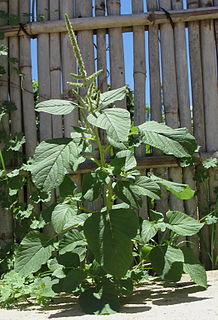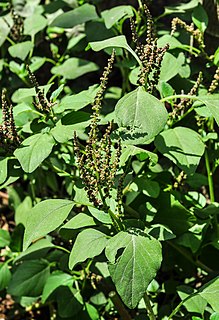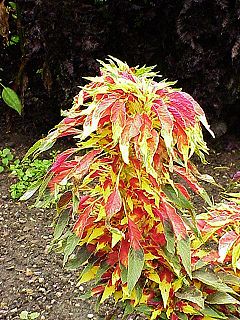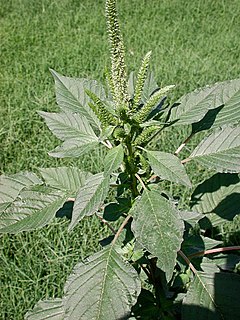
Amaranthus is a cosmopolitan genus of annual or short-lived perennial plants collectively known as amaranths. Some amaranth species are cultivated as leaf vegetables, pseudocereals, and ornamental plants. Most of the Amaranthus species are summer annual weeds and are commonly referred to as pigweeds. Catkin-like cymes of densely packed flowers grow in summer or autumn. Amaranth varies in flower, leaf, and stem color with a range of striking pigments from the spectrum of maroon to crimson and can grow longitudinally from 1 to 2.5 metres tall with a cylindrical, succulent, fibrous stem that is hollow with grooves and bracteoles when mature. There are approximately 75 species in the genus, 10 of which are dioecious and native to North America with the remaining 65 monoecious species endemic to every continent from tropical lowlands to the Himalayas. Members of this genus share many characteristics and uses with members of the closely related genus Celosia. Amaranth grain is collected from the genus. The leaves of some species are also eaten.

Blitum bonus-henricus, also called Good-King-Henry, poor-man's asparagus, perennial goosefoot, Lincolnshire spinach, Markery, English mercury, or mercury goosefoot, is a species of goosefoot which is native to much of central and southern Europe.

The Amaranthoideae are a subfamily of the Amaranthaceae. The stamens have anthers with two lobes (locules) and four pollen sacs. The main distribution of the subfamily is in tropical America, in tropical and Southern Africa, and in Australia.

Amaranthus blitum, commonly called purple amaranth or Guernsey pigweed, is an annual plant species in the economically important plant family Amaranthaceae.

Amaranthus viridis is a cosmopolitan species in the botanical family Amaranthaceae and is commonly known as slender amaranth or green amaranth.
Amaranthus wrightii is a species of flowering plant. It goes by the common name of Wright's amaranth. It occurs from western Texas into southern Arizona and as far north as Colorado at elevations between 500–2,000 m (1,600–6,600 ft).

Amaranthus caudatus is a species of annual flowering plant. It goes by common names such as love-lies-bleeding, pendant amaranth, tassel flower, velvet flower, foxtail amaranth, and quilete.

Amaranthus hypochondriacus is an ornamental plant commonly known as Prince-of-Wales feather or prince's-feather. Originally endemic to Mexico, it is called quelite, bledo and quintonil in Spanish.

Amaranthus retroflexus is a species of flowering plant in the family Amaranthaceae with several common names, including red-root amaranth, redroot pigweed, red-rooted pigweed, common amaranth, pigweed amaranth, and common tumbleweed.

Amaranthus tricolor, known as edible amaranth, is a species of flowering plant in the genus Amaranthus, part of the family Amaranthaceae.

Amaranthus palmeri is a species of edible flowering plant in the amaranth genus. It has several common names, including carelessweed, dioecious amaranth, Palmer's amaranth, Palmer amaranth, and Palmer's pigweed.

Amaranthus albus is an annual species of flowering plant. It is native to the tropical Americas but a widespread introduced species in other places, including Europe, Africa, and Australia.

Amaranthus cruentus is a flowering plant species that yields the nutritious staple amaranth grain. It is one of three Amaranthus species cultivated as a grain source, the other two being Amaranthus hypochondriacus and Amaranthus caudatus. In Mexico, it is called huautli (Spanish pronunciation: [ˈwawtli] and alegría ([aleˈɣɾi.a] and in English it has several common names, including blood amaranth, red amaranth, purple amaranth, prince's feather, and Mexican grain amaranth. In Maharashtra, it is called shravani maath or rajgira. In Kerala, it is called chuvanna cheera or commonly, cheera .In Karnataka, it is called "Dantina soppu" or harive soppu.

Species belonging to the genus Amaranthus have been cultivated for their grains for 8,000 years. Amaranth plants are classified as pseudocereals that are grown for their edible starchy seeds, but they are not in the same botanical family as true cereals, such as wheat and rice. Amaranth species that are still used as a grain are Amaranthus caudatus L., Amaranthus cruentus L., and Amaranthus hypochondriacus L. The yield of grain amaranth is comparable to rice or maize.

Amaranthus deflexus is also known by the common names low amaranth, Argentina amaranth, perennial pigweed, and large-fruit amaranth. It is native to South America, and has been introduced to many other parts of the world. It is a short-lived perennial or annual plant. The plant can grow up to 1.5 ft in height.

Amaranthus graecizans, the Mediterranean amaranth or short-tepalled pigweed, is an annual species in the botanical family Amaranthaceae. It is native to Africa, southern Europe, East Asia to India and Central Asia. It is naturalized in North America. More general common names include tumbleweed and pigweed.
Amaranthus watsonii is a species of amaranth known by the common name Watson's amaranth. It is native to the southwestern United States and northern Mexico, where it grows in sandy places such as deserts and beaches, and disturbed areas. It is also known as a rare introduced species in parts of Europe. This is an erect annual herb producing a glandular hairy stem to a maximum height of about a meter. The leaves are generally oval-shaped and up to 8 centimeters long, with a petiole of up to 9 centimeters. The species is dioecious, with male and female individuals producing different types of flowers. The inflorescence is a long spike cluster of flowers interspersed with spiny green glandular bracts. The fruit is a smooth capsule about 2 millimeters long that snaps in half to reveal a small shiny reddish black seed.

Acroglochin persicarioides is a species of flowering plants in the plant family Amaranthaceae. It is distributed from the Himalayas to China. The systematic position of the genus Acroglochin in subfamily Betoideae is still uncertain.















